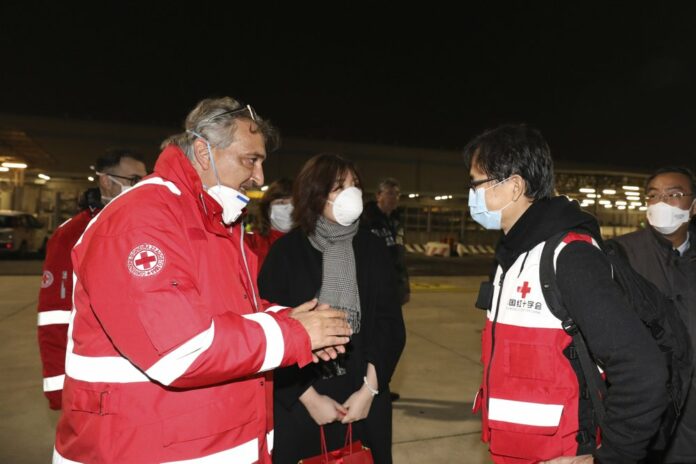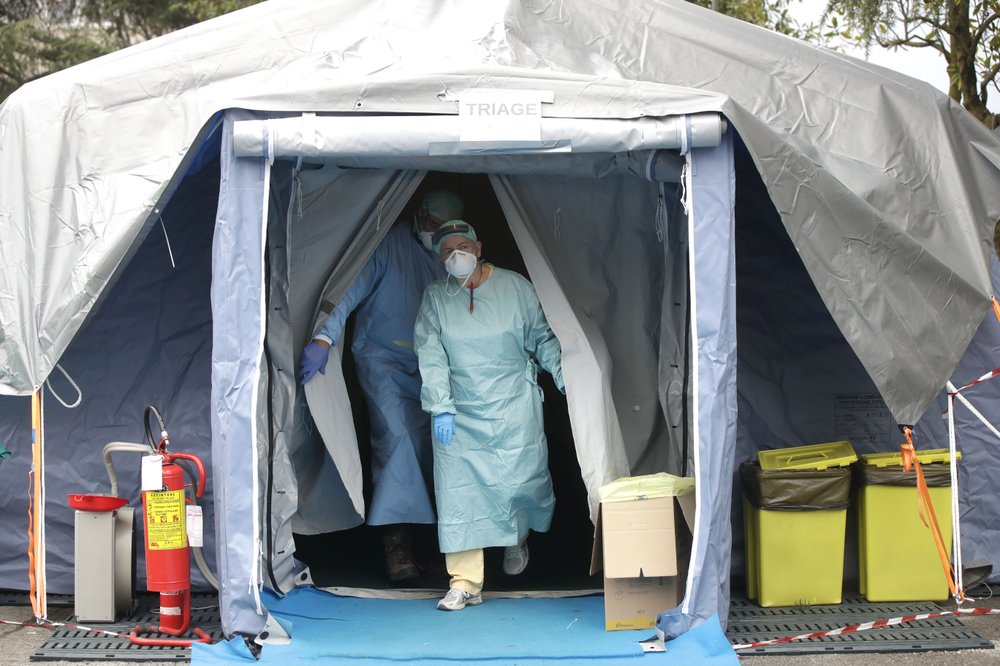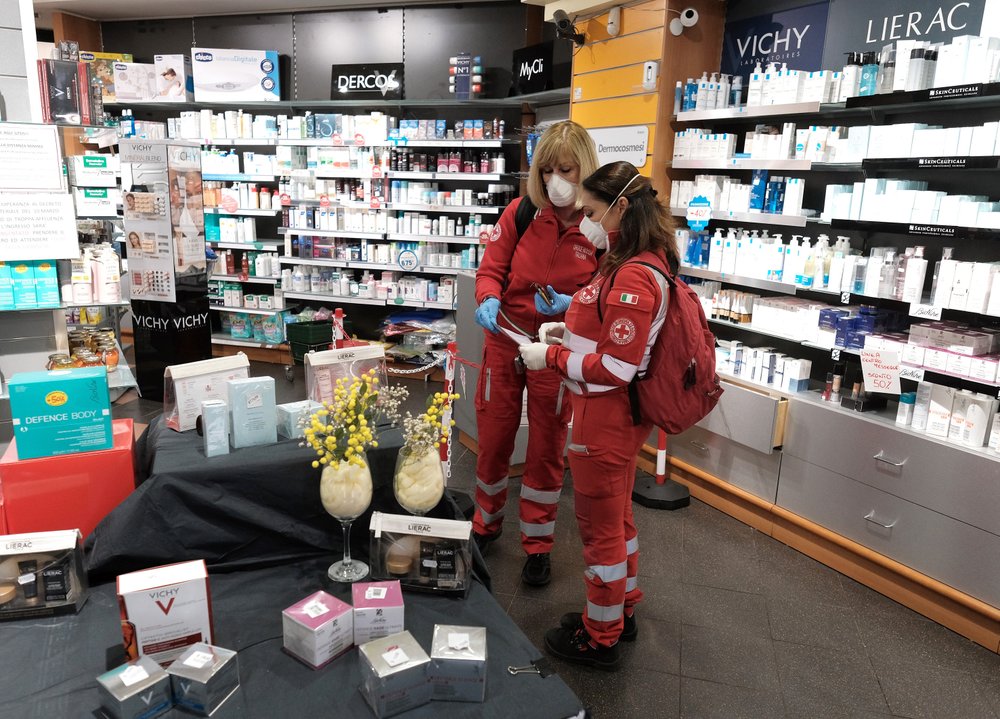
ROME (AP) — Talk of a 400-bed field hospital in Milan’s fairgrounds. A team of Chinese experts and surplus ventilators arriving on a cargo plane. Doctors Without Borders, usually dispatched to the third world when disasters strike, working triage in Italy’s prosperous north.
The coronavirus outbreak tearing through Italy has turned a nation that usually donates medical expertise and equipment abroad into a country in need. Some hospitals in hard-hit Lombardy are at saturation point, unable to admit new patients. Every day is a scramble to find more intensive care beds than the critically ill who need them. There still aren’t enough protective masks to go around.
The doctors who tended to the first patients in the north are now sounding the alarm to colleagues in Italy and abroad, warning of what will come and urging them to prepare.
“It’s not a wave. It’s a tsunami,” said Dr. Roberto Rona, in charge of intensive care at the Monza hospital. “It’s something that makes you change completely how you run a hospital.”
Three weeks ago Friday, Italy’s health care emergency began in the small Lombard town of Codogno. It has since exploded into the biggest source of infections in what is now a worldwide pandemic.
Italy’s high death rate — currently over 7% and double the average globally — has been blamed on its unusually old population, which is second only to Japan’s. But about a third of the ICU patients in Lombardy are aged 50-64, meaning the virus isn’t just striking the very old, but also Italians still in their working prime.

“We are trying to understand why the mortality rate seems so high compared to other countries, and why patients seem more critical than in other countries,” said epidemiologist Paolo D’Ancona at the National Instititutes of Health.
As of Friday, Italy had 17,660 positive cases and 1,266 dead, more than any country outside China. Lombardy alone accounts for 55% of the infected and 70% of the dead. The government has imposed a nationwide lockdown, closing stores and restaurants, curbing public transport and telling the population of 60 million to stay home except for absolute need.
On Friday, Italy welcomed a team of nine Chinese doctors and nurses as well as 11 tons of ventilators, monitors, protective masks and other surplus medical equipment. It was a remarkable turnabout, with the country where the virus broke out late last year offering assistance to the European epicenter, now that its own caseload is in retreat.
Francesco Rocca, head of the International Red Cross and Red Crescent and himself an Italian, choked up as the pallets were offloaded from the China Eastern Airlines charter flight.
“We, the Italian Red Cross, are not used to receiving donations,” Rocca said. “We normally donate.”
But Italy is desperate, and offers of other European assistance haven’t been pouring in. Already, the civil protection service has erected more than 500 triage tents outside hospitals nationwide.
Lombardy officials had drafted a proposal to build a Wuhan-style field hospital on the grounds of Milan’s fairgrounds to accommodate the expected ICU overflow. But Italy’s Civil Protection agency nixed the idea, saying it can’t equip it in time.
This week, the government passed a decree allowing Lombardy to make new medical hires, and there’s now a “Help Wanted” sign on the regional government’s Facebook page. As of Thursday, 650 doctors and nurses had applied and 100 had been hired, said Lombardy health chief, Giulio Gallera.
But it’s not enough. Doctors Without Borders dispatched teams to four Lombardy hospitals, including hard-hit Lodi and Codogno, which had to close its emergency room to new patients because it was so overwhelmed. The extra support of nurses, epidemiologists and other experts will enable the hospitals to reopen 20 more beds to patients.
But in some hospitals, even with extra hands to help, there simply aren’t enough beds to go around.
“We cannot continue to accumulate patients,” Gallera said. “We have to have the ability to move out patients who improve, otherwise our ability to receive new ones is exhausted.”
“In some hospitals, we have already arrived at that point,” he said.
Gallera denied that ICU capacity was so limited that doctors had changed the criteria for ICU admissions. Earlier this week, the Italian society of anesthesiologists had issued 15 recommendations of ethical and medical criteria to consider if ICU beds are exhausted, saying doctors may have to adopt more wartime triage criteria of gauging who has the best chance of survival versus “first come, first served.”
“There are no activities in our guidelines that say some people are privileged, or that some age categories are privileged,” Gallera insisted. “The work of our doctors is aimed at treating and saving the lives of all patients.”
But he conceded: “Certainly now we are in a situation where it is difficult to do so.”

Earlier this week, an Italian group of ICU specialists hosted a video conference call involving some of the front-line personnel who were on duty when the first wave of patients started arriving over the weekend of Feb. 21.
“Clearly we ran out of ventilators, masks … on Day 2,” said Dr. Pier Giorgio Villani, who was on duty in Lodi when Patient No. 1 was transferred from Codogno. “It was a big mess.”
Freya Jephcott, an infectious diseases expert at Cambridge University, acknowledged that the epidemic in Italy appears slightly different than elsewhere in Europe.
“The high case fatality rate is probably attributable to the older population, but we have to be slightly careful to see how the outbreak develops,” she said.
The World Health Organization has previously estimated that about 3.4% of people infected with COVID-19 globally have died. But the agency has emphasized that its estimate is a crude mathematical calculation and that the true death rate is likely to be far lower. Officials in the U.S., U.K. and elsewhere have estimated the death rate is likely closer to about 1%.
Death rates often fluctuate during the early stages of an outbreak because officials are mostly looking for the most severe cases. According to data from China, the death rate in Wuhan was nearly 6% versus 0.7% in other parts of the country. WHO reported that in China’s outbreak, nearly 22% of people over 80 who caught COVID-19 died.
The average age of Italy’s dead is 80.3; only 25.8% of them are women.
As Italy continues the battle, it is urging others to wake up and get prepared. A group of Italian doctors based in France delivered a three page appeal to French doctors offering urgent suggestions and advice for coping with the coronavirus. They are calling for a European coordination center to help manage the pandemic so that the rest of Europe can learn from Italy’s experience.
But aside from China, the solidarity isn’t necessarily being reciprocated.
Italy’s Civil Protection chief acknowledged that other European services have been less than generous in offering to help out, because of contagion fears.
On Friday, the governor of Lombardy wrote to the German health minister, asking him to authorize for export the sale of respirators after Chancellor Angela Merkel pledged to help Italy out.
“Everyone says there’s a great, united Europe,” Gallera said. “Now is the time to show it.”
AP Medical Writer Maria Cheng in London and AP visual journalist Trisha Thomas in Rome contributed.
















































